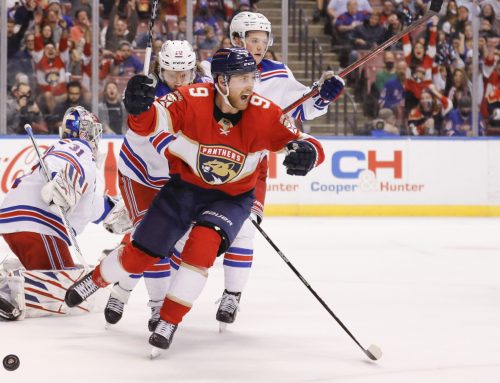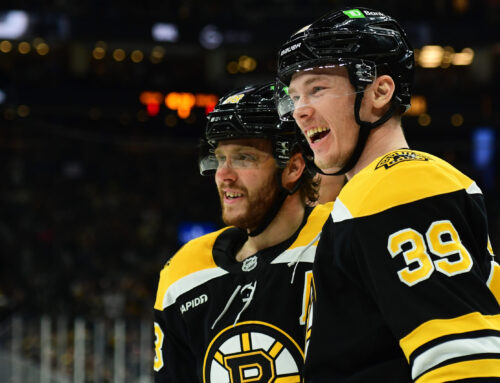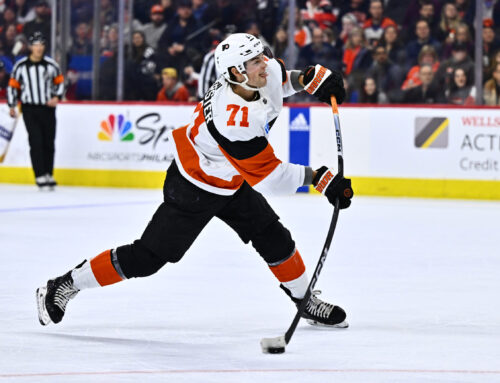The Eastern Conference Final had its moments, but for the sake of competition I hope the Stanley Cup Final requires more games to complete. Despite being swept, the Hurricanes deserved a better fate, since they lost all four games by one goal and two in overtime. In fact, the shot total over the four games was 65-60, 38-26, 32-17, and 39-24 – all in favor of Carolina. That's what happens when you run into a hot goalie.
Speaking of Sergei Bobrovsky, I'm still not raising his value for next season. Yes, he's been earning his pile of money over the last month and a half, but over a longer sample size he's an inconsistent goalie. If you've experienced him on your fantasy team, he can be either brilliant or disastrous. For example, he was in the top 10 in quality starts (30 QS), but he was also just outside the top 10 in really bad starts (10 RBS) this season. How many quality starts does it take to recover from a really bad start – two? Maybe three? Over the regular season, he was basically a hair below average (-3.21 GSAA).
Alex took my thought one step further, moving Bobrovsky down in his most recent Goalie Cap League Rankings. Counterintuitive? It's certainly zigging when others might be zagging. He explains why below.
The truth is that the Panthers are probably a better team than what they showed during the regular season. But let's face it: their current run is unsustainable over a full season. Next season, I think they'll do a better job of hanging around perennial playoff teams Boston, Toronto, and Tampa Bay during the regular season, and then they won't sneak up on us like they have in the 2023 playoffs.
As for Matthew Tkachuk, he's a legitimate star in this league who is raising his game when the stakes are highest. If you don't consider him among the elite, keep in mind that he's posted back-to-back 100-point seasons for two different teams. Only the Oilers twin towers of Connor McDavid and Leon Draisaitl have more points over the past two seasons than Tkachuk (213). He's number 4 in my Roto Rankings, and I have no plans to drop that ranking. You'd need a very convincing argument to talk me out of it.
Maybe this series has a different outcome with Max Pacioretty and/or Andrei Svechnikov in the lineup, or at least it could have lasted longer. Pacioretty may play a grand total of five games as a Hurricane, as he's set to become a UFA. In fact, there's a whole bunch of UFAs on the Canes, so there's a major opportunity for a retool if they want one. Even though the Canes went to the Conference Final while missing the two legitimate top-6 forwards they were expecting in the lineup, they could look very different once the puck drops on the 2023-24 season. Carolina's philosophy under Rod Brind'Amour has been more about fitting into the system than building around stars.
–
In case you missed it, Joe Pavelski's overtime winner in Game 4 makes him the all-time leader in playoff goals among active players with 73 goals. Not Alex Ovechkin (72), not Sidney Crosby (71). Pavelski. There has to be a Hall of Fame case for him by now.
Pavelski is aging like fine wine. Some of this might be attributed to goal inflation, but even by removing that he's defying the normal production curve anyway.
Career average: 0.81 PTS/GP
Average last 3 seasons, ages 36-38: 0.95 PTS/GP
–
Throughout the summer, I'll be touring through the various Frozen Tools stat categories, looking for players that stood out in some unusual way in the hopes of finding some hidden fantasy value. I'll kick things off with a category that isn't used that often in fantasy leagues but indirectly affects many fantasy categories: time on ice (TOI). I'll clarify that TOI is used in one of my leagues, although it doesn't have a major effect on overall performance.
First, some basic observations. The top 39 performers in TOI/GP were defensemen. That should come as little surprise, as teams dress four forward lines but only three defensive pairs. In addition to that, teams tend to lean heavily on their top defensemen, given how much more valuable those defensemen are compared to replacement-level d-men.
The 2022-23 icetime leader among all players was Cale Makar, who averaged 26:23 TOI. That shouldn't be a huge surprise, and neither should the player with the highest average TOI among forwards. Connor McDavid averaged 22:23 per game, which happened to be the same icetime total as David Savard, who wasn't even the icetime leader on the Canadiens.
Next, some players of note in the icetime category.
Among the top 30 in icetime, Larsson sticks out as having the only player (defenseman) to receive less than 10% of his team's available power-play time (he received just 3.5%PP). That resulted in a significant amount of even-strength icetime for Larsson (20:40), with only six players receiving more even-strength time. Paired with Vince Dunn for most of the season, Larsson received just 0:02 less icetime per game than his partner. Larsson was the stay-at-home conscience on the pairing while also receiving considerably more penalty-killing time than PP1 QB Dunn.
Even though Larsson's scoring numbers paled in comparison to Dunn's, he had his best offensive season anyway (33 PTS in 82 GP). Larsson reached 30 points for the first time in his career while also posting career highs in plus-minus (+27) and shots on goal (143). Larsson also led the Kraken with 222 hits and 173 blocked shots, another byproduct of high icetime. In fact, combine the career-best scoring with the excellent peripherals and Larsson suddenly has considerable fantasy value. In fact, Larsson was ranked 51 in one Yahoo head-to-head multicategory league that I'm in.
Finally, a general hockey-related question to ponder. The Oilers were widely considered the team getting fleeced in the infamous "trade is one for one" with New Jersey in 2016. But in 2023, which player would you rather have on your hockey team's roster: Larsson or Taylor Hall?
Ovechkin was one of about 30 forwards to average at least 20 minutes of icetime per game. Yet it's his power-play time that stands out, as he led all players with 4:42 of power-play icetime per game (minimum 10 GP). That worked out to 96.5% of the Capitals' available power-play minutes. No other player averaged more than 80% of his team's available power-play minutes. All of that power-play time meant that Ovie averaged only 15:28 of even-strength time – a number that doesn't really matter in fantasy but could affect his advanced stat metrics from a 5-on-5 production standpoint.
That power-play icetime number is the highest of Ovechkin's career, but it isn't that unusual for him, since he's received at least 90% of the Capitals' power-play minutes for the last five seasons. Ovechkin's presence on the power play may be beneficial for usual PP1 options such as John Carlson, but it could keep certain other secondary scorers from getting much of a taste of the power play. For example, Anthony Mantha registered only 2 PPP while receiving only 17.6% of available power-play minutes. Sonny Milano was a little more productive than Mantha, managing 5 PPP with only 16.2% of the available power-play minutes.
Don't expect anything to change as Ovechkin attempts to track down Wayne Gretzky for the all-time goal record. The quickest path for that involves loading up on power-play time. With the exception of the COVID-shortened 2020-21 season, Ovie has reached double-digit power-play goals every season since 2011-12.
–
I'll share some more players with interesting ice time totals tomorrow. Until then, follow me on Twitter @Ian_Gooding for more fantasy hockey.





 MTL
MTL CAR
CAR WPG
WPG ANA
ANA N.J
N.J DET
DET NSH
NSH DAL
DAL VAN
VAN VGK
VGK S.J
S.J EDM
EDM TOR
TOR CBJ
CBJ CHI
CHI L.A
L.A CGY
CGY
